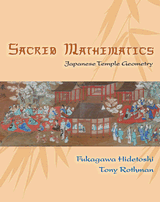
Temple bells die out.Temples
The fragrant blossoms remain.
A perfect eve ning!
—Bashō
No visitor to a foreign country has failed to experience the fascination and unease that accompanies an encounter with unknown traditions and customs. Some visitors attempt to overcome their fears, while the majority quickly retreats to familiar shores, and in this lies a distinction: Those who embrace culture shock are travelers; those who do not are tourists.
The most profound culture shock comes about when one is confronted by a different way of thinking. Most of us can hardly imagine walking into a Western church or cathedral to encounter stained glass windows covered by equations and geometrical figures. Even if we can conceive of it, the thought strikes us as alien, out of place, perhaps sacrilegious. Yet for well over two centuries, Japanese mathematicians—professionals, amateurs, women, children—created what was essentially mathematical stained glass, wooden tablets adorned with beautiful geometric problems that were simultaneously works of art, religious offerings, and a record of what we might call "folk mathematics." The creators of these sangaku—a word that literally means "mathematical tablet"—hung them by the thousands in Buddhist temples and Shinto shrines throughout Japan, and for that reason the entire collection of sangaku problems has come to be known as "temple geometry," sacred mathematics.
In this book you will be invited not only to encounter temple geometry but to appreciate it. There is a bit of culture shock to be overcome. A single glance at a sangaku is enough for one to realize that they were created by a profoundly different esthetic than the Greek-inspired designs found in Western geometry books. On a deeper level, one learns that the methods Japanese geometers employed to solve such problems differed, sometimes significantly, from those of their Western counterparts. Ask any professional mathematician whether the laws of mathematics would be the same in another universe and he or she will reply, of course. Real mathematicians are Pythagoreans—they cannot doubt that mathematics exists independently of the human mind. At the same time, during their off hours, mathematicians frequently speculate about how different mathematics could look from the way it is taught in Western schools.
Click on the following photos from the book to view a larger version.





